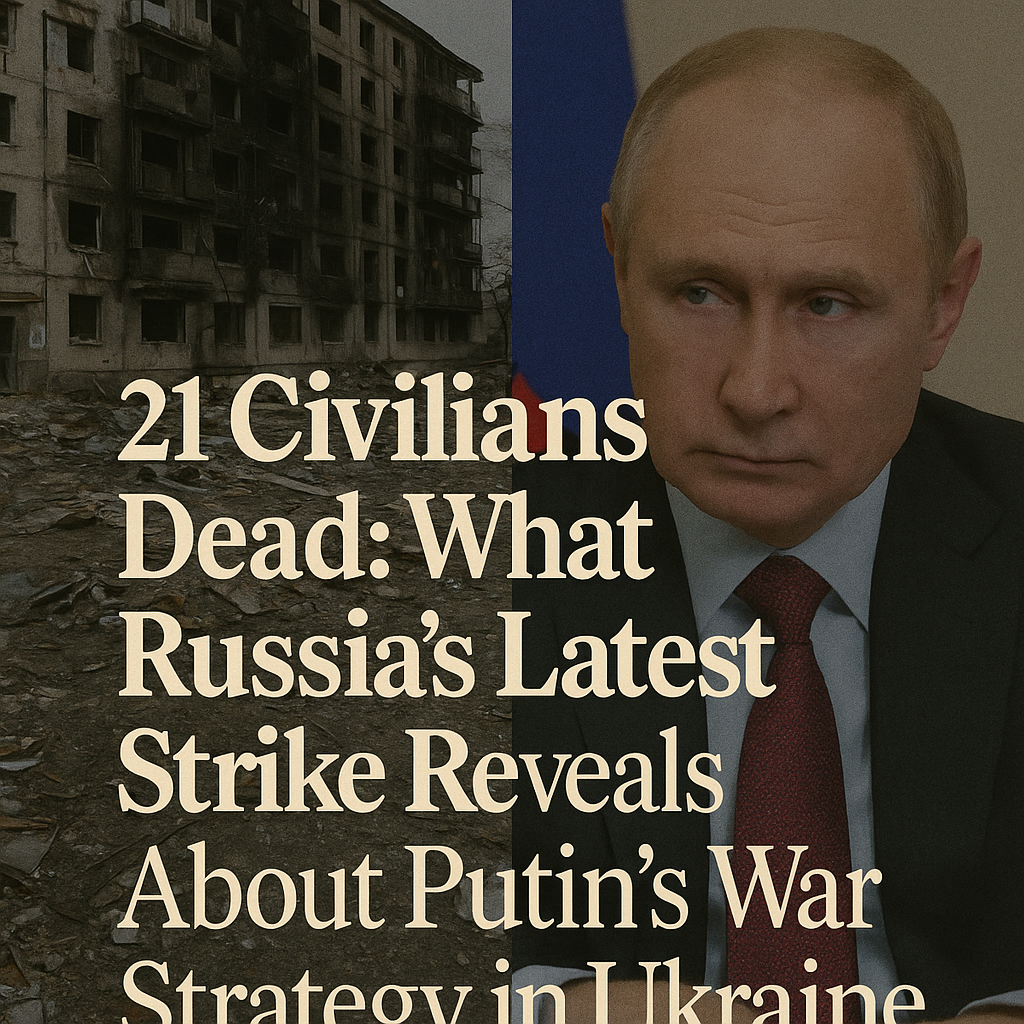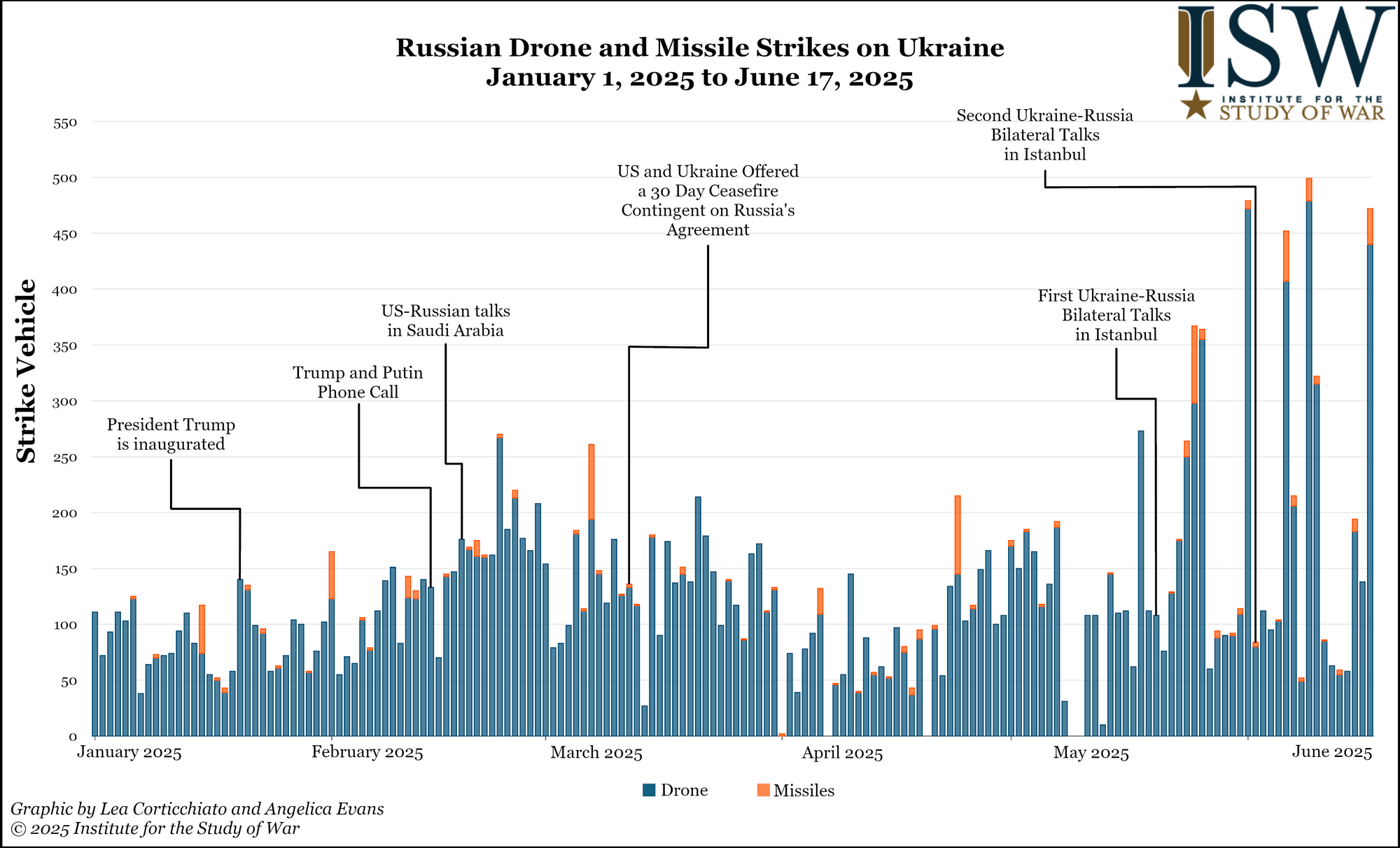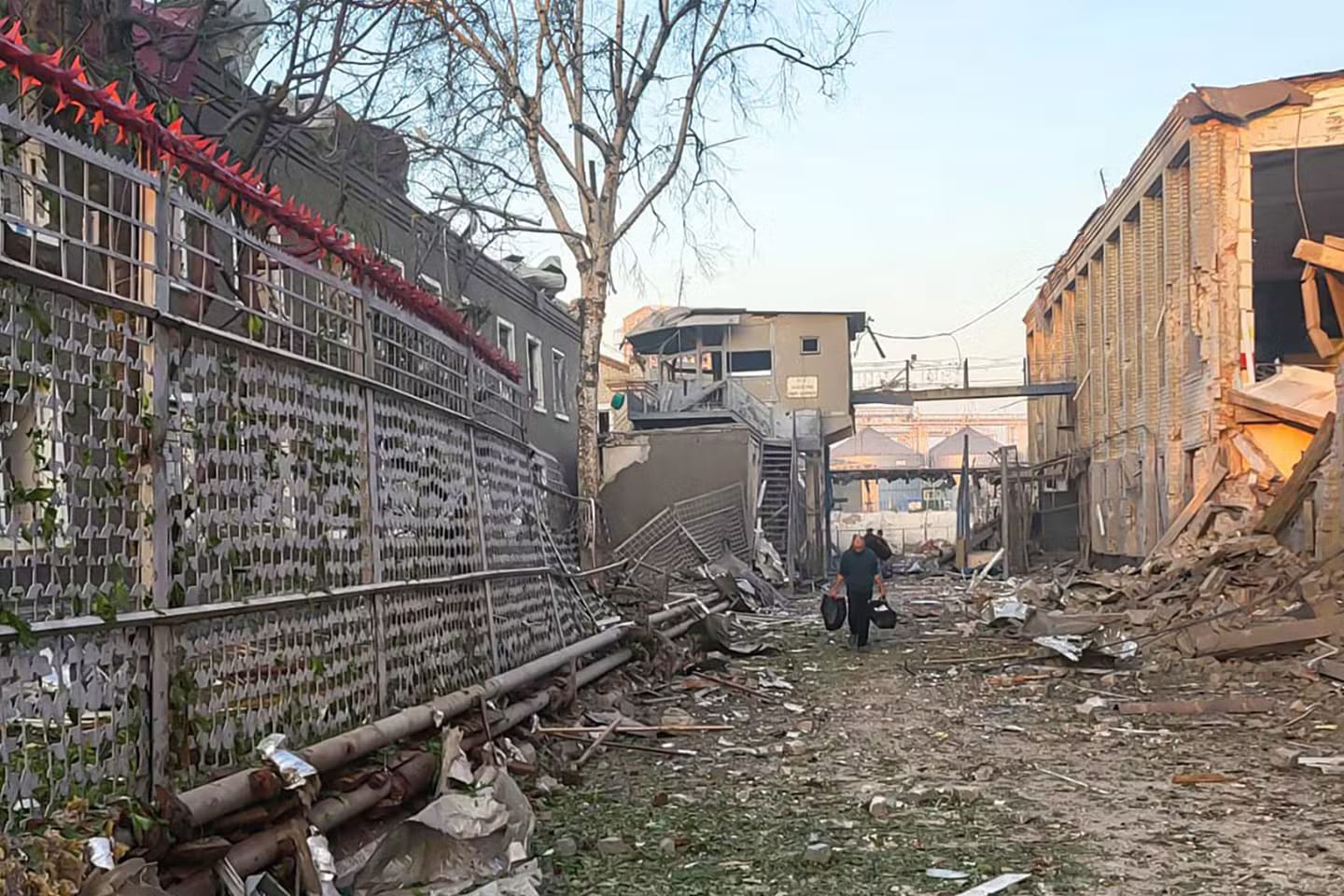Putin's Bloody Calculus: Why Russia’s Latest Civilian Strike is a Deliberate Message to the West
A Russian missile strike kills 21 civilians in Kropyvnytskyi, exposing Putin's brutal war strategy. Delve into a pattern of war crimes in Ukraine, Moscow's defiance of the West, and the high-stakes test for NATO and U.S. policy. Read our deep-dive analysis of Russia's bloody calculus.

Written by Lavanya, Intern, Allegedly The News
KYIV, Ukraine, July 30, 2025
The morning air over Kropyvnytskyi, a city that had largely been spared the direct horrors of the front line, still tastes of ash. Yesterday, just after 10 a.m., a Russian missile slammed into the central market, transforming a scene of everyday commerce into a landscape of carnage. At least 21 people, shoppers, vendors, a mother and child buying fruit, were killed. Rescue workers, their faces grim under layers of dust, speak of the impossible task of identifying victims from the mangled wreckage of stalls and human lives. This was not a stray rocket; it was a message, delivered with precision and intended for multiple audiences.
Understanding that message is critical to deciphering Vladimir Putin’s evolving war strategy, the West's increasingly strained response, and the dangerous geopolitical chessboard of 2025. The strike comes at a moment of profound global uncertainty. Tensions are simmering between Moscow and Washington, fueled by contradictory and inflammatory statements from President Donald Trump, who has publicly claimed he could "end the war in 24 hours," while simultaneously undermining U.S. commitments to NATO.
Moscow’s decision to launch such a flagrant attack on a civilian target in this fraught environment is a calculated act of defiance. It reveals a brutal, multi-pronged strategy that leverages terror as a weapon, relentlessly tests Western resolve, and expertly exploits the deep political divisions within the United States.
A Pattern of Brutality: The Strategic Significance of Civilian Suffering
To dismiss the Kropyvnytskyi market strike as a targeting error is to willfully ignore a well-documented and systematic pattern of behavior. Since the outset of the full-scale invasion in 2022, international observers and human rights organizations have meticulously recorded Russia’s violations of international humanitarian law. This is not random violence; it is a core component of Russia's military doctrine.
This strategy serves multiple, cynical purposes:
- Psychological Warfare: The core principle is to make life unlivable. Attacks on markets, train stations, residential blocks, and power plants are designed to terrorize the Ukrainian population, shattering any illusion of safety far from the front lines. The aim is to grind down morale, foment internal dissent, and ultimately pressure the government in Kyiv to capitulate under the weight of civilian suffering.
- Straining National Resources: Each missile that hits a civilian target triggers a massive, resource-intensive response. It pulls emergency services, medical teams, and civil defense units away from other critical tasks, including supporting the war effort. It forces the state to spend billions on rebuilding and humanitarian aid, diverting funds that could otherwise be used for defense.
- Coercive Diplomacy: These acts of brutality are a form of violent, non-verbal negotiation. They are a signal to Ukraine and its allies that the cost of continued resistance will be paid in civilian blood. It's a dark gamble that the West's stomach for such images will weaken before Russia's missile stockpiles do, forcing Ukraine into a disadvantageous peace.
This marks a strategic evolution from the war’s initial phase, which was premised on a "shock and awe" campaign to decapitate the government in Kyiv swiftly. That failed. The current strategy is a long, grinding war of attrition, where civilian pain is not a byproduct but a central objective. As a detailed 2023 report from the UN's Independent International Commission of Inquiry on Ukraine concluded, Russian forces have engaged in "indiscriminate and disproportionate attacks," which constitute war crimes.
Ukraine, in response, has mastered the art of turning tragedy into strategic leverage. Raw, often graphic visuals from Kropyvnytskyi were immediately disseminated by official government channels and ordinary citizens on platforms like Telegram and X (formerly Twitter). President Zelenskyy’s powerful nightly addresses, often delivered from somber locations, frame the horror in a direct appeal to the world’s conscience, translating grief into urgent requests for Patriot batteries, F-16s, and tighter sanctions. His government's United 24 fundraising platform uses these moments to galvanize global public support, ensuring the world cannot look away.

The Timeline of Tragedy: Major Attacks on Civilians Since 2022
The Kropyvnytskyi strike is the latest entry in a horrifying ledger. Understanding this timeline is key to recognizing the systematic nature of the violence.
- March 16, 2022 – Mariupol Drama Theater: Russian aircraft dropped two 500kg bombs on the theater where hundreds of civilians were sheltering. An Associated Press investigation concluded that the attack was far deadlier than estimated, likely killing close to 600 people. The word "CHILDREN" was written in giant letters on the ground outside, visible from the air, a fact that underscores the deliberateness of the attack.
- April 8, 2022 – Kramatorsk Railway Station: A Russian Tochka-U ballistic missile, equipped with a cluster munition warhead, struck a crowded train station plaza during an evacuation of civilians. The attack killed 63 people, including nine children, and wounded over 150. Inscribed on the missile casing was the phrase "For the children", a cynical message of revenge.
- March-April 2022 – The Bucha Massacre: After Russian troops withdrew from the suburbs of Kyiv, international journalists and investigators uncovered horrific scenes. Mass graves, bodies of civilians with hands tied behind their backs, and evidence of widespread torture and summary executions came to light. The events in Bucha prompted global outrage and led to formal accusations of war crimes and crimes against humanity.
- January 14, 2023 – Dnipro Apartment Building: A Russian Kh-22 missile—an outdated, notoriously inaccurate anti-ship weapon designed to take out aircraft carriers—tore through a nine-story apartment complex. It killed 46 people, including six children, and left dozens more missing. Amnesty International labeled the attack a likely war crime, highlighting the inherent recklessness of using such a weapon in a residential area.
- July 29, 2025 – Kropyvnytskyi Central Market: The most recent strike. Preliminary analysis from Ukrainian authorities suggests a modern Kalibr cruise missile was used, which makes claims of a "targeting error" highly suspect. The choice of a civilian market at a peak hour points toward an intentional act of terror.
Moscow’s Geopolitical Gambit: Defying Trump and Testing the West
Russia’s decision to escalate with the Kropyvnytskyi strike while President Donald Trump's rhetoric dominates U.S. political discourse is a masterclass in geopolitical opportunism. The Kremlin is acutely aware of and actively leveraging the internal politics of its chief adversary. Trump’s isolationist "America First" posture and his open questioning of the value of NATO create a climate of profound uncertainty that Russia is ruthlessly exploiting.
There are several layers to Moscow’s defiance of Western warnings and Trump's rhetoric:
- Calling a Perceived Bluff: From the Kremlin's perspective, Trump’s statements are viewed as political theater for a domestic base, not as coherent foreign policy. By launching a brazen attack now, Russia is testing the West's resolve. Is there a real red line, or are American warnings, especially under a potentially isolationist president, hollow? The strike is a way to find out.
- Creating Irreversible "Facts on the Ground": Russia is likely intensifying its campaign to cripple Ukraine’s infrastructure and society before a potential U.S. administration change. The goal is to degrade Ukraine's ability to function as a state to such a degree that any future diplomatic solution heavily favors Moscow, regardless of who is in the White House.
- A Strategy of Brinkmanship to Fracture Alliances: This defiance is also a direct message to Europe. It signals that Russia is not intimidated by Washington and that European nations must fend for themselves. This is a calculated attempt to exacerbate policy divisions within NATO, particularly between hawkish frontline states like Poland and the Baltic nations, and more cautious legacy powers like Germany and France. It forces them to question the reliability of the U.S. security guarantee.
This leads to a critical assessment of Trump's recent statements: are they a bluff, brinkmanship, or a prelude to policy escalation? Most European diplomats and intelligence analysts believe it is a combination of bluff and brinkmanship. However, the extreme danger is that this rhetoric, intended to project unpredictability, could provoke Moscow into a fatal miscalculation, leading to a direct confrontation with a NATO country that it wrongly assumes the U.S. will not defend.

Technology of Terror: Precision Failures or Intentional Targeting?
The technical debate over Russia's targeting often centers on its missile technology. Analysts frequently point to Russia's reliance on aging, inaccurate munitions like the Kh-22 (used in Dnipro) or its use of S-300 air defense missiles in a ground-attack role, for which they are not designed and are notoriously imprecise.
However, the argument that high civilian tolls are merely the result of "precision failures" collapses under scrutiny. The consistent and repeated use of such weapons in densely populated areas constitutes, at a minimum, indiscriminate attacks, which are explicitly prohibited under the Geneva Conventions.
Furthermore, painstaking work by open-source intelligence groups like Bellingcat using satellite imagery, geolocation of video footage, and analysis of munition fragments has repeatedly demonstrated that many of Russia’s most devastating strikes were conducted with modern, precision-guided munitions like the Kalibr or Iskander. When a high-precision missile hits a pizzeria, a shopping mall, or a central market and not the military installation kilometers away, the claim of "error" becomes a transparent falsehood. It reveals a targeting doctrine where inflicting terror on the civilian population is not an accident but a specific, intended outcome.
The Global Response: Shifting Alliances and the Impotence of Law
The Kropyvnytskyi strike, like those before it, sends ripples across the globe, forcing a continuous recalibration of policy and military posture.
- A Reinvigorated NATO: The war has shattered any lingering complacency within NATO. The alliance is more unified and determined than at any point since the Cold War. Finland has joined, adding a long, strategic border with Russia, and Sweden’s membership has been solidified. Battle groups in frontline states have been scaled up to brigade size, and defense spending across the alliance has surged.
- Shifting European Policies: Germany's historic Zeitenwende ("turning point") has transformed it from a hesitant partner into a major military backer of Ukraine, supplying everything from Leopard 2 tanks to advanced air defense. France is supplying long-range SCALP cruise missiles, enabling Ukraine to strike high-value targets deep behind Russian lines. Poland has not only become the central logistics hub for all aid flowing into Ukraine but also one of Europe’s most powerful land armies and an unwavering advocate for a hardline stance against Moscow.
- The Limits of International Law: Despite the mountain of evidence, the path to legal accountability is fraught with obstacles. The ICC has issued arrest warrants for Vladimir Putin and his Commissioner for Children's Rights, Maria Lvova-Belova, for the unlawful deportation of children. However, the ICC has no police force and relies on member states to make arrests—an impossibility as long as Putin remains in power. Efforts to create a special tribunal for the crime of aggression are ongoing, but face complex legal and political hurdles. For the families of the 21 victims in Kropyvnytskyi, justice remains a distant, almost abstract, promise.

What Happens Next? The High-Stakes Chessboard
The strike on Kropyvnytskyi signals an intent to escalate, pushing the conflict into an even more dangerous phase.
- Accelerated Ukrainian Demands: Kyiv will leverage this atrocity to intensify its pleas for the tools it needs to protect its skies and retaliate effectively. This means more Patriot and SAMP/T air defense systems, faster delivery of F-16 fighter jets, and, crucially, the lifting of restrictions on using Western-supplied long-range weapons to strike legitimate military targets inside Russian territory.
- A Test of Western Resolve: The West will respond with more sanctions, but their impact is now largely marginal. The real test will be whether it provides the game-changing weaponry Ukraine is requesting, a decision fraught with fears of provoking a wider war.
- Russia's Winter Campaign: Moscow will likely feel emboldened. Having faced only condemnation for its actions, it is almost certain to repeat its 2022/2023 winter strategy of systematically targeting Ukraine’s energy grid to plunge the country into cold and darkness.
- The Looming Risk of Miscalculation: With the U.S. political landscape in turmoil and Russia acting with increasing impunity, the risk of a direct clash between Russian and NATO forces—whether from a stray missile in Poland or a more deliberate provocation in the Black Sea—is alarmingly high.
A Strategy of Calculated Barbarism
The 21 civilians murdered in the Kropyvnytskyi market were not collateral damage; they were the intended victims of a state-sanctioned strategy of calculated barbarism. Vladimir Putin is waging a total war in which the distinction between soldier and civilian has been purposefully and systematically erased. This terror campaign is designed to break Ukraine’s spirit while simultaneously probing the political and moral fault lines of a distracted and divided West.
Russia is making a deadly wager: that the democratic world’s unity is fragile, its attention span is fleeting, and its ultimate fear of escalation will override its commitment to justice. The missile that hit the Kropyvnytskyi market was more than just an explosion; it was a clear articulation of Putin's worldview. It was a declaration that in his pursuit of victory, there are no laws to obey, no civilians to spare, and no price too high for others to pay.
Beyond Condemnation: The Unanswered Questions
As the world issues its now-routine statements of condemnation, deeper and more difficult questions linger. How does the 24-hour news cycle's portrayal of these tragedies shape policy in Western capitals, and does it create pressure for short-term gestures over long-term strategy? Are broad economic sanctions, which have a slow and diffuse impact, a sufficient moral or strategic response to the immediate, visceral horror of a marketplace massacre? And most critically, at what point, if ever, does the international doctrine of "Responsibility to Protect" compel a more direct intervention, even with the terrifying risk of escalation with a nuclear power?
Sources
United Nations Office of the High Commissioner for Human Rights (OHCHR),Amnesty International,Human Rights Watch, Yevhen Titov, ACLED, ISW, Associated Press,Bellingcat Open Source Investigations, International Criminal Court (ICC), and Council of the European Union.




